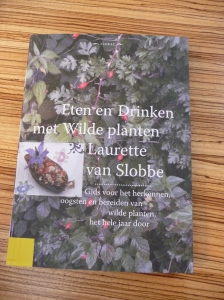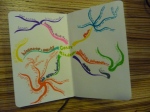We’re two days into our experiment! Happy new year to everybody!

Making lunch to go
The first of these days is not really worth mentioning, consumeless and sustainability-wise. We spent New Year’s Eve at friends in The Hague and New Year’s Day at Eise’s family. We went home after dinner so we didn’t have to purchase anything ourselves yesterday. We did however leave for The Hague right before lunch time on Thursday, so we brought our own sandwiches! Consumeless act number one.
Today was more of a day according to our new lifestyle. We did nothing special (doing some new year’s cleaning) and there were hardly any moments we had to think twice before doing something. We did buy six energy saving light bulbs to replace the last ‘normal’ bulbs in our house. And Eise had to go to both the supermarket and the organic food store (in stead of the super market only) to buy organic ingredients for our food this weekend. We had dinner completely according to our rules: we ate pumpkin, with onions, garlic and goat’s cheese (all organic) from the oven, risotto (not organic, but we still had it in stock) and (organic) salad.

Dinner
Dinner brought us a (tiny) dilemma though. We usually leave the oven door open after taking out the food in order to let out the remaining heat. However, we have a oven/microwave oven combination which has an automatic light that switches on when the door is open. The question now is: does the heat from the oven that adds to the temperature in our kitchen outweigh the energy that is used for the light? I think not, but I’m not sure…
A related problem would arise (we just thought) when we want to heat something to drink. In winter, we like to drink hot apple juice with cinnamon (De Werf-style). What would be better: heating the apple juice in the microwave oven or in a pan on the stove? We have a halogen stove, but I have no clue whether heating something on this stove requires more energy than heating it in the microwave oven.
It’s not so easy, this applying consuming less and consuming sustainably to all aspects of our daily life!
A question that was asked a couple of times the last few days was how essential we thought visiting family and friends was (refering to our first rule, saying we only buy things if we really need them). We haven’t made up any rules about this except for the transportation rules. We have been thinking about this issue and decided not to make a special rule for this. The idea of this experiment was to try to live our lives as consumeless and as sustainably as possible, and our lives include visiting family and friends. Of course we will keep the transportation rules in mind all year!
Finally, a shocking fact I just came across reading National Geographic’s Green Guide (which I found in our stack of magazines I was sorting out), related to cotton production (which we’ve dicussed in the post Inspiration as well): “Conventional cotton production uses more than 18 percent of the world’s pesticides”! We’re seriously considering to never buy any other cotton than organic cotton in the future. Which is not too difficult anymore. Most mainstream stores (H&M, C&A, HEMA) have cotton basics these days. And buying organic jeans is not difficult as well (Kuyichi, Levi’s, Ascension, and probably many more).
So, this really is the start of our experiment to live as consumeless and as sustainable as possible for a year. We hope to hear from all of you, so please let us know what you think of our rules, our experiences and our blog! We are happy to receive any tips and suggestions!
..
Click to subscribe to this blog via e-mail
Click to subscribe to this blog via RSS
 We’re nearly out of dog and cat food, so we have to buy new. This is the first time we really think about sustainable food for our pets so I started searching for ‘green’ food. I knew the brand Yarrah, which is sold at our local organic food store. We’ve once tried a test package of catfood of this brand with our cat (which we don’t have anymore), but we didn’t really like the fact that the cat pooped much more because of the food. Now this would not be an issue anymore because we don’t have a litter box in our house. The cats can go out as they please. We haven’t tried Yarrah dog food yet.
We’re nearly out of dog and cat food, so we have to buy new. This is the first time we really think about sustainable food for our pets so I started searching for ‘green’ food. I knew the brand Yarrah, which is sold at our local organic food store. We’ve once tried a test package of catfood of this brand with our cat (which we don’t have anymore), but we didn’t really like the fact that the cat pooped much more because of the food. Now this would not be an issue anymore because we don’t have a litter box in our house. The cats can go out as they please. We haven’t tried Yarrah dog food yet.







